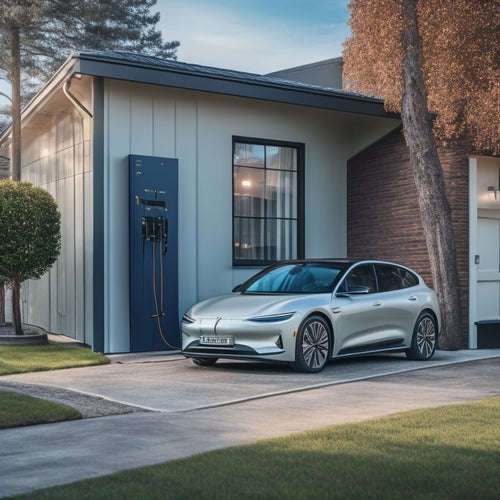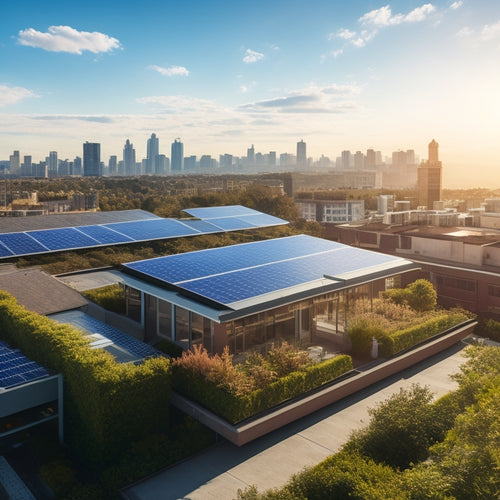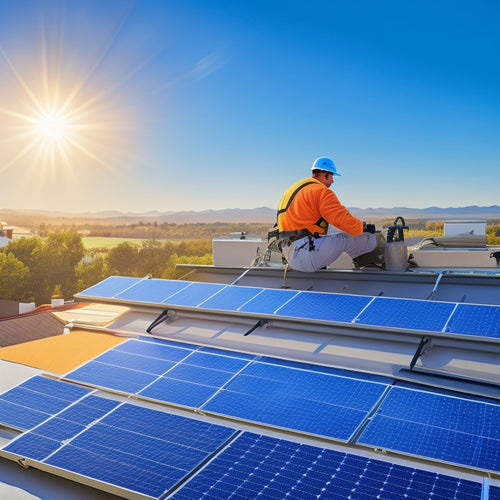
Solar Power Storage Systems for Renewable Energy
Share
You're looking to utilize the full potential of renewable energy with solar power storage systems, and you're on the right track. By storing excess energy generated by solar panels, you can reduce your reliance on the grid, save on energy costs, and contribute to a more sustainable future. With advancements in battery technology, energy storage methods, and power backup systems, you can guarantee a steady power supply even during low solar radiation periods. As you investigate the possibilities, you'll uncover the various types of solar power storage systems, essential components, and factors to evaluate for a superior solution, and reveal the exciting developments shaping the future of solar storage technology, waiting to be examined.
Key Takeaways
- Solar power storage systems reduce environmental impact by storing excess energy for low sunlight periods, decreasing reliance on the grid.
- Advanced battery technologies, like lithium-ion, increase efficiency and cost-effectiveness, enabling reliable and efficient solar energy usage.
- Hybrid systems combine solar power with backup sources like diesel generators or wind power, ensuring uninterrupted power supply during low solar radiation periods.
- Energy storage methods, including pumped hydro, thermal, battery, and compressed air, ensure steady power supply from solar systems and enhance reliability.
- Financial incentives, such as tax credits, rebates, and financing options, offset initial investment costs, making solar power storage systems a viable option for renewable energy.
Benefits of Solar Power Storage
By virtue of integrating a solar power storage system into your renewable energy setup, you can access a plethora of benefits that considerably enhance the overall efficiency and reliability of your solar power generation.
You can reduce your environmental impact by storing excess energy generated during the day for use during periods of low sunlight or at night. This results in a significant decrease in your reliance on the grid, leading to cost savings and increased energy independence.
Moreover, solar power storage systems contribute to grid stability by providing a buffer against power fluctuations, guaranteeing a smoother supply of renewable energy.
In addition, integrating a solar power storage system into your home can improve overall home efficiency by optimizing energy usage. You may also be eligible for incentive programs, such as tax credits or rebates, which can offset the initial investment in your system.
The rapid pace of technological innovation in this field assures that these systems are becoming increasingly efficient and affordable, making them a viable option for those seeking to maximize their renewable energy potential.
How Solar Power Storage Works
You'll find that solar power storage works through various energy storage methods, which enable you to store excess energy generated by your solar panels during the day for use during the night or on cloudy days.
These methods often incorporate power backup systems, ensuring a reliable supply of electricity even when the sun isn't shining.
Advances in battery technology have greatly improved the efficiency and cost-effectiveness of these systems, making them a viable option for homeowners and businesses alike.
Energy Storage Methods
Utilizing the power of the sun requires a reliable means of storing excess energy generated during the day for use during the night or on cloudy days.
You need a system that can efficiently store and release energy as needed. Energy storage methods play an essential role in ensuring a steady supply of power from solar energy systems.
Several energy storage methods are available, including:
-
Pumped Hydro Storage: This method involves pumping water from a lower reservoir to an upper reservoir during the day, using excess energy generated by solar panels. During the night or on cloudy days, the water is released back to the lower reservoir, generating electricity through hydroelectric turbines.
-
Thermal Storage: This method involves heating or cooling a material, such as molten salt, during the day, and using the stored thermal energy to generate electricity when needed.
-
Battery Storage: This method involves using batteries, such as lithium-ion or lead-acid batteries, to store excess energy generated during the day for use during the night or on cloudy days.
- Compressed Air Energy Storage: This method involves compressing air in an underground reservoir during the day, using excess energy generated by solar panels. During the night or on cloudy days, the compressed air is released, expanding through a turbine to generate electricity.
These energy storage methods enable you to utilize the power of the sun and use it when you need it, making solar energy a reliable and efficient source of power.
Power Backup Systems
Your solar power storage system's backup capabilities are vital in guaranteeing uninterrupted power supply during periods of low solar radiation or at night. This is particularly important for off-grid solutions, where the system isn't connected to the grid and must rely on its own resources. In such cases, a reliable backup system guarantees that you have a steady supply of power, even when the sun isn't shining.
A hybrid system that combines solar power with a backup power source, such as a diesel generator or wind power, can provide a reliable solution. This setup allows you to tap into the backup power source when the solar power system isn't generating enough electricity. The hybrid system can be configured to automatically switch between the two power sources, guaranteeing a seamless changeover and minimizing downtime.
When designing a power backup system, it's vital to contemplate factors such as the size of the backup power source, the capacity of the energy storage system, and the automation and control systems that manage the changeover between power sources.
Battery Technology Advances
In tandem with the advancement of solar power systems, battery technology has undergone significant changes, revolutionizing the way you store and use solar energy. You now have access to more efficient and cost-effective energy storage solutions.
Battery technology advancements have been driven by the need for higher energy density, longer lifetimes, and reduced costs. You benefit from these improvements through:
-
Lithium chemistry: Improved lithium-ion batteries offer higher energy density, longer lifetimes, and lower self-discharge rates.
-
Advanced materials: New materials have been developed to enhance battery performance, such as graphene-based electrodes and advanced separators.
-
Modular designs: Modular battery systems enable you to scale up or down to meet specific energy storage needs.
- Smart battery management: Advanced battery management systems (BMS) optimize battery performance, longevity, and safety.
These advancements have altered the way you store and use solar energy, enabling you to utilize the full potential of renewable power.
Types of Solar Power Storage Systems
When it comes to utilizing the power of the sun, one crucial aspect of solar energy systems is the storage of excess energy generated during the day for use during periods of low sunlight or at night.
You'll want to evaluate the type of solar power storage system that best fits your needs.
There are several solar battery types to choose from, including lead-acid, lithium-ion, and nickel-cadmium. Each has its own advantages and disadvantages, so it's important to research and compare them.
For instance, lithium-ion batteries are known for their high energy density and long lifespan, but they're also typically more expensive.
Hybrid systems are another option, combining different battery technologies to provide a more efficient and cost-effective solution.
These systems can optimize energy storage and reduce waste, making them a popular choice for many solar energy users.
Solar Power Storage System Components
As you investigate the world of solar power storage systems, understanding the components that make up these systems is fundamental for ideal performance and efficiency. A well-designed system guarantees that your solar power generation is maximized, and your energy storage is dependable.
The key components of a solar power storage system include:
-
Solar Panels: These convert sunlight into electrical energy, which is then stored in the battery bank. Seamless solar panel integration is imperative for efficient energy harvesting.
-
Inverters: These devices convert DC power from the solar panels or battery bank to AC power for your home or business. Inverter compatibility with your solar panel setup is essential for optimal performance.
-
Battery Bank: This is where excess energy is stored for later use. The type and size of the battery bank depend on your energy needs and usage patterns.
- Monitoring and Control Systems: These track your energy production, storage, and consumption in real-time, enabling you to maximize your system's performance and identify potential issues.
Choosing the Right Solar Storage Solution
With your solar power storage system components in place, the next essential step is to select a solar storage solution that aligns with your energy needs and goals.
You'll want to take into account factors such as storage efficiency, installation costs, and grid integration to guarantee a seamless connection to the grid. Additionally, evaluate the environmental impact of your chosen solution, as well as its maintenance requirements, to assure minimal downtime and maximum uptime.
You should also research available solar incentives, such as tax credits or rebates, that can help offset the upfront costs of your system.
Moreover, contemplate user experiences and market trends to get a sense of which solutions are most popular and effective. By assessing these factors, you can make an informed decision that meets your energy needs and budget.
Ultimately, the right solar storage solution will provide you with a reliable, efficient, and cost-effective way to utilize the power of the sun.
Future of Solar Power Storage Technology
Now that you've selected the ideal solar storage solution for your needs, it's time to look ahead to the advancements on the horizon. The future of solar power storage technology holds much promise, with ongoing innovations ready to overcome current limitations and drive adoption.
Several solar innovation trends are emerging to address grid integration challenges:
-
Advancements in Battery Chemistry: Ongoing research into new battery materials and designs is expected to increase energy density, reduce costs, and enhance overall performance.
-
Smart Inverters and Power Electronics: Next-generation inverters will enable seamless grid integration, advanced monitoring, and real-time control, ensuring a stable and efficient flow of renewable energy.
-
Grid-Scale Energy Storage Systems: Large-scale storage solutions will play a significant role in stabilizing the grid, mitigating intermittency, and providing a reliable supply of renewable energy.
- Artificial Intelligence and IoT Integration: The integration of AI and IoT technologies will optimize energy storage, predict energy demand, and enable real-time monitoring and control of solar power systems.
These advancements will be essential in overcoming the grid integration challenges associated with widespread renewable energy adoption, ultimately clearing the path for a more sustainable and efficient energy future.
Frequently Asked Questions
Are Solar Power Storage Systems Compatible With Existing Solar Panel Installations?
As you gaze at your existing solar panel installation, you wonder: can I seamlessly integrate solar power storage systems? Rest assured, most modern solar battery systems are designed for compatibility, ensuring efficient energy conversion and hassle-free integration with your current setup.
How Long Do Solar Power Storage Systems Typically Last?
You're wondering how long your storage system will last. Typically, you can expect a lifespan of 10-15 years, depending on maintenance requirements, with some manufacturers offering up to 20-year warranties, meeting your lifetime expectations for reliable energy storage.
Can Solar Power Storage Systems Be Used for Grid-Tied Systems?
You can use solar power storage systems for grid-tied systems, leveraging energy management to optimize your battery capacity and supply excess energy back to the grid, while also providing backup power during outages.
Are Solar Power Storage Systems Eligible for Government Incentives?
You might think incentives are scarce, but you're eligible for government rebates and tax credits when investing in battery technology, yielding significant financial savings, and it's not limited to off-grid systems, so you can reap benefits with grid-tied installations too.
Can Solar Power Storage Systems Be Monitored and Controlled Remotely?
You can remotely monitor and control your energy storage systems, utilizing advanced energy management platforms that provide real-time data and analytics, enabling you to optimize performance, identify issues, and make data-driven decisions from anywhere.
Related Posts
-

5 Essential Tips for Buying EV Charging Systems Online
When purchasing an EV charging system online, you'll want to make sure you're making an informed decision. First, det...
-

What Is the Cost to Put in Solar Panels
You're likely considering solar panels for your home, and the most significant factor in your decision is the upfront...
-

3 Essential Steps for Solar Electricity Installation
To guarantee a successful solar electricity installation, you'll need to follow three essential steps. First, assess ...


